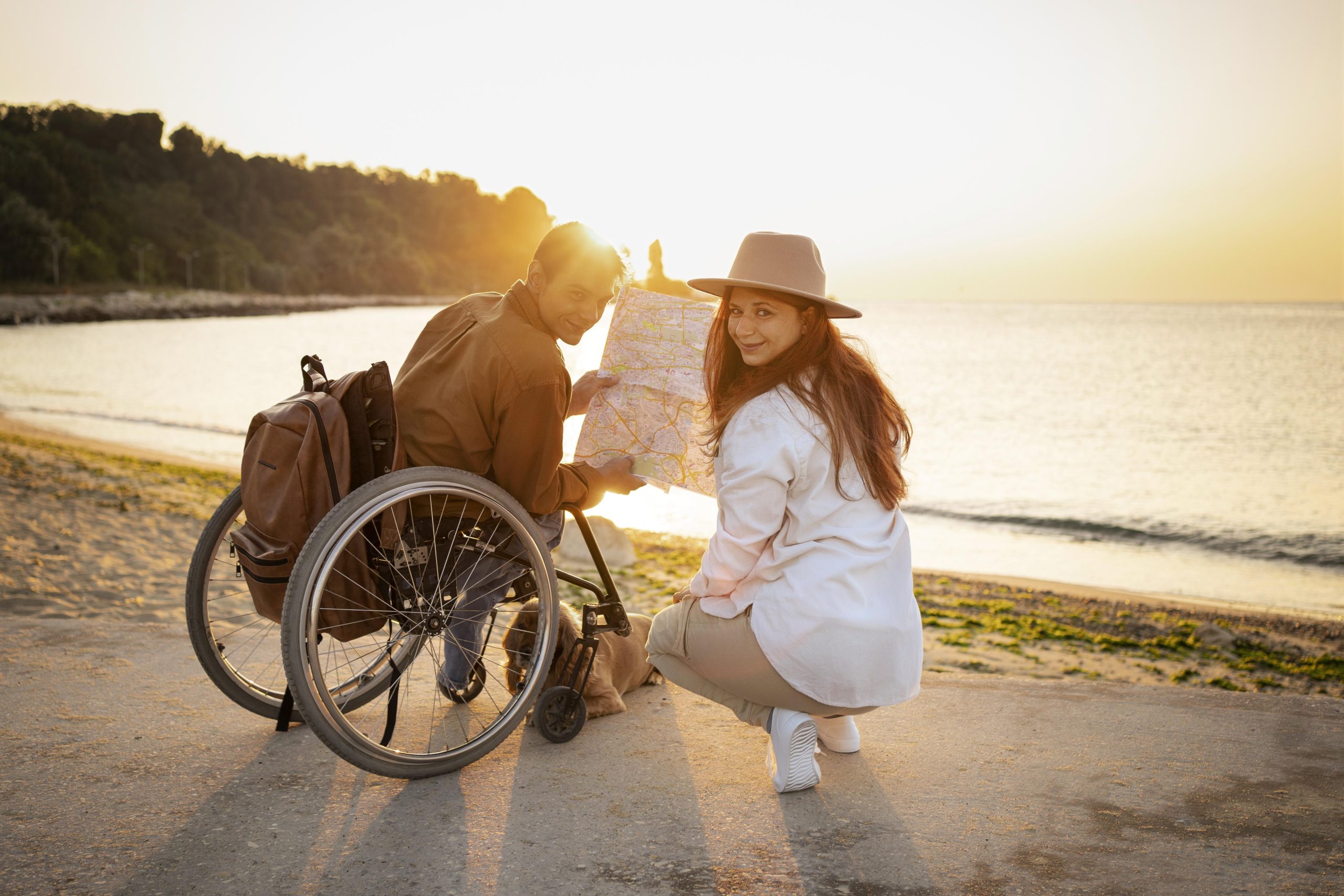- No products in the cart.
Ensuring Accessibility and Safety: A Comprehensive Guide to Packing Essential Mobility Products for Travel
Travelling with a mobility impairment can present unique challenges, but with the right preparation and equipment, it’s possible to embark on exciting journeys with confidence and ease. In this blog, we will explore the essential mobility products you need to pack, share tips for choosing the right mode of transportation, provide guidance on navigating airports and train stations, offer insights on booking accessible accommodations, discuss effective communication strategies, highlight accessible attractions and activities, provide tips for navigating public spaces, and offer important safety advice for travellers with mobility challenges. Whether you use a wheelchair, mobility scooter, rollator, or other mobility aids, we have you covered. Get ready to embark on unforgettable adventures while ensuring accessibility, comfort, and peace of mind throughout your travels.
Packing Essential Mobility Products
Wheelchair or scooter: If you use a wheelchair or scooter, make sure to pack it with all the necessary parts. You may also want to pack a backup wheelchair or scooter in case your primary one breaks down.
Portable ramps, travel scooters, lightweight wheelchairs and other mobility aids suitable for travelling are available at Mobility Caring.
Choosing the right mode of transportation
Your destination: The distance and terrain of your destination will help you decide which mode of transportation is best. For example, if you are traveling to a city, you may want to consider taking public transportation or walking. If you are traveling to a rural area, you may want to consider renting a car or taking a taxi.
Your mobility level: If you have a mobility impairment, you may need to choose a mode of transportation that is accessible to you. For example, if you use a wheelchair, you will need to make sure that the transportation you choose is wheelchair accessible.
Mobility products such as foldable walkers and portable power wheelchairs are some of the best transportation devices available at Mobility Caring.
Navigating Airports and Train Stations
Plan before you go, research the airport or train station to learn about the accessible routes and services. This includes knowing where the accessible entrances and exits are, what the accessible restrooms are like, and what the accessible transportation options are:
- Ask for help: If you need help getting around, do not be afraid to ask for it. Many airports and train stations have staff members who are trained to help people with disabilities.
- Use accessible transportation: Many airports and train stations offer accessible transportation options, such as wheelchair assistance, electric carts, and accessible vans.
Mobility aids like rollators, travel walkers and travel-friendly canes to help in moving through transportation easily are available at Mobility Caring.
Booking Accessible Accommodations
- Start your research early: Start looking for accessible accommodations as soon as you know your travel dates. This will give you more time to find the perfect place and to make sure that the accommodations are available.
- Be specific about your needs: When you are searching for accessible accommodations, be specific about your needs. This will help you narrow down your search and find the accommodations that are right for you. For example, if you use a wheelchair, you will need to make sure that the accommodations have a wheelchair-accessible room.
A range of mobility-friendly bedroom aids like bathroom safety products and grab bars available at Mobility Caring could be useful in accessible accommodations.
Communicating your needs
Communicating your needs when traveling with a mobility impairment is important to ensure that you have a safe and enjoyable experience. Here are some tips on how to communicate your needs effectively:
- Be proactive: Don’t wait until you’re at your destination to communicate your needs. Start by letting your travel agent or tour operator know about your mobility impairment. They can help you book accessible accommodations and transportation.
- Be specific: When you are communicating your needs, be as specific as possible. This will help the people you are communicating with understand exactly what you need. For example, if you use a wheelchair, you will need to let them know the dimensions of your wheelchair so they can make sure your accommodations are big enough.
- Be positive: Communicating your needs can be challenging, but it’s important to stay positive. The people you’re communicating with want to help you have a safe and enjoyable experience.
Mobility aids like bed rails, bed sticks and transfer aids from Mobility Caring can assure a safe and comfortable stay.
Accessible attractions and activities
- National Parks: Most national parks have accessible trails, overlooks, and other features that allow people with mobility impairments to enjoy the outdoors.
- Museums: Several museums have accessible exhibits and programs that are designed for people with all abilities.
- Zoos: Most zoos have accessible exhibits and rides that allow people with mobility impairments to see and interact with animals
- Theme parks:Several theme parks have accessible rides, shows, and attractions that allow people with mobility impairments to enjoy the park.
- City tours:Several companies offer accessible city tours that allow people with mobility impairments to see the sights of a city.
- Water activities:There are many accessible water activities that people with mobility impairments can enjoy. For example, many accessible beaches and pools have wheelchair-accessible ramps and lifts.
Mobility aids from Mobility Caring like lightweight travel wheelchairs, portable ramps and mobility scooters could be used to enjoy exploring destinations conveniently.
Navigating public spaces
Navigating public spaces with a mobility impairment can be challenging, but there are several things you can do to make it easier. Here are few tips:
- Plan: Before you go, research the public space to learn about the accessible routes and services. This includes knowing where the accessible entrances and exits are, what the accessible restrooms are like, and what the accessible transportation options are.
- Use accessible maps: There are many accessible maps available online and in print. These maps can help you find your way around public spaces and identify accessible features.
- Ask for help: If you need help getting around, do not be afraid to ask for it. Many public spaces have staff members who are trained to help people with disabilities.
- Use accessible signage: Many public spaces have accessible signage that can help you find your way around. This signage is often in Braille and large print
- Use a mobility aid: If you use a wheelchair or scooter, bring it with you and use it to get around.
Mobility Caring has mobility aids like rollators, crutches and walking frames which are suitable to manoeuvre through sidewalks, public transportation and tourist areas without a hassle.
Safety Tips for Travelers with Mobility Challenges
- Plan: Before you travel, research your destination to learn about the accessible routes and services. This includes knowing where the accessible entrances and exits are, what the accessible restrooms are like, and what the accessible transportation options are.
- Stay aware of your surroundings: When you are traveling, be aware of your surroundings. This includes paying attention to uneven surfaces, stairs, and narrow walkways.
- Travel with a companion: If you can, travel with a companion who can help you if you need it.
- Be aware of your limits: Don’t try to do too much. Take a break if you are exhausted or feeling stressed.
- Stay hydrated: It is important to stay hydrated, especially if you are traveling in hot weather.
- Take your medication: Consistently take your prescribed medications.
- Pack a first-aid kit: Pack a first-aid kit with basic supplies, such as bandages, antibiotic ointment, and pain relievers.
- Use a mobility aid: If you use a wheelchair or scooter, bring it with you and use it to get around.
- Use accessible transportation: If you are travelling to a destination that is not accessible by foot, use accessible transportation. This could include a wheelchair-accessible bus, train, or taxi.
- Ask for help from staff: If you need help getting around, do not be afraid to ask for help from staff.
- Be aware of your rights: As a traveller with a mobility challenge, you have certain rights. These rights include the right to accessible transportation, accessible accommodations, and accessible public spaces.
Safety-focused mobility products like walking canes available at Mobility Caring are best suited for safety.












Leave a Reply